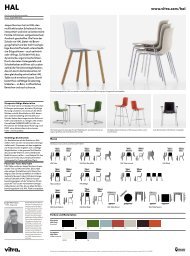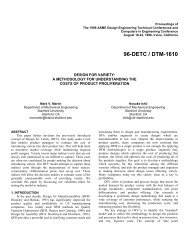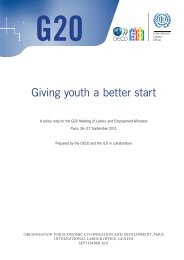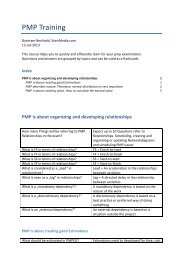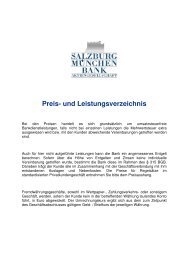Gamification Whitepaper
Create successful ePaper yourself
Turn your PDF publications into a flip-book with our unique Google optimized e-Paper software.
GAMIFICATION<br />
THE SERIOUS BUSINESS OF FUN – WHAT GAMIFICATION<br />
AND SOCIAL MEDIA MEAN FOR BANKING<br />
White Paper
The serious business of fun – What gamification and social media mean for banking<br />
<strong>Gamification</strong> and social media are changing the way people engage and<br />
expect to engage with their friends and increasingly their employers<br />
and service providers. Banks now have new ways to be relevant, engage<br />
customers and improve sales. This paper sets out Misys’ view of the key<br />
trends and opportunities for banks.<br />
Introduction<br />
Fun is big business. Annually, the computer game<br />
industry makes $115bn. The phenomenal success of<br />
this industry, which is now bigger than Hollywood, is<br />
attributable to the fact that it appeals to fundamental<br />
elements of human nature: competition, reward,<br />
problem solving and social connection. <strong>Gamification</strong><br />
is the term for an approach to marketing and sales<br />
that employs the attributes of gaming to engage<br />
customers, change behaviours and expectations.<br />
The basics of gamification have been around for<br />
some time. Foursquare has been awarding badges<br />
and ranking users for location check-ins since 2009.<br />
The principles of gamification have also been<br />
adopted by companies like IBM 1 and Salesforce 2 .<br />
Gartner has also highlighted gamification as a key<br />
trend for CIOs 3 - and it has been covered in American<br />
Banker 4 .<br />
Social media has also changed the way people<br />
connect, discover, recommend and share. With the<br />
internet providing a huge amount of choice, index<br />
search is being replaced by recommendations from<br />
friends, family and people we trust, through social<br />
media. It’s a self-moderating quality control system<br />
that threatens traditional marketing and distribution<br />
models whilst simultaneously providing viral means to<br />
spread the word, good or bad.<br />
Financial services companies are experimenting with<br />
these concepts to get ahead of the curve and<br />
differentiate themselves in the market. Misys believes<br />
this trend will grow. In a world where customer<br />
relationships are increasingly digital, banks cannot<br />
afford to be left behind.<br />
1 Kudos Badges http://www.kudosbadges.com/<br />
2 Salesforce Rypple http://rypple.com/social-goals<br />
3 Gartner Press Release: http://www.gartner.com/it/page.jsp?id=1629214<br />
4 American Banker http://www.americanbanker.com/issues/177_112/<br />
Jane-McGonigal-asserts-gaming-could-improve-mobilebanking-1050022-1.html?zkPrintable=1&nopagination=1<br />
2 White Paper
The serious business of fun – What gamification and social media mean for banking<br />
What is <strong>Gamification</strong>?<br />
<strong>Gamification</strong> is the use of games or competition to<br />
encourage a user to complete an action or set of<br />
actions. Users respond to a range of prompts and are<br />
encouraged to return regularly to the application. The<br />
prompts include:<br />
Competition – adding league tables motivates<br />
participants to try and come top. Users either<br />
compete with friends (if there is integration with social<br />
media) or other users like them. This is a core feature<br />
of Foursquare.<br />
Awards – giving badges and rewards provides a<br />
sense of achievement and progress and encourages<br />
users to continue to use the application.<br />
Countdowns – by making certain features and<br />
actions available only for a limited time, customers<br />
are motivated to act before it’s too late.<br />
Scarcity – we assign more value to opportunities<br />
perceived to have limited availability. Scarcity can<br />
drive us to act based on opportunities being scarce<br />
or likely to become scarce. This is a concept used by<br />
Cokezone and www.Gilt.com.<br />
Incentives & Penalties – here penalties, traps and<br />
roadblocks are used to steer people away from<br />
certain behaviours. Rewards and access to privileges<br />
are used to encouraged desirable behaviours.<br />
Penalties can be applied for not doing things, e.g. if<br />
you don’t make a regular payment, you will be<br />
removed from a competition or giveaway or slip<br />
down a league table.<br />
Goal Setting & Progression – we love creating and<br />
working on things we can then “own”. This is a<br />
perfect dynamic for financial services companies and<br />
is exemplified by www.mint.com, whereby customers<br />
create goals and work to achieve them, such as a<br />
house, a renovation, car or a child’s education. This<br />
dynamic is often coupled with progression, providing<br />
a user with statistics and historical data along the way.<br />
Personalisation – by letting a customer add their<br />
own images and choose their own themes for their<br />
account, a customer has a great sense of control,<br />
investment and can continue to develop their<br />
relationship with the site or app. This can be seen in<br />
the new Facebook covers concept.<br />
Team work – as well as individual pursuits, we can be<br />
drawn to collective goals, providing an opportunity to<br />
help others or be rewarded as a group. Groupon<br />
have had great success with “The Deal is On” feature.<br />
Offering a reward if a communal target is hit has also<br />
been the basis of American Express’ Small Business<br />
Saturday on Facebook in the US 5 .<br />
By deploying these dynamics in a co-ordinated<br />
application, a bank can use games to motivate<br />
behaviours and drive outcomes for both the customer<br />
and the organisation.<br />
<strong>Gamification</strong> should not be confused with simple<br />
marketing. Certainly it can provide excellent<br />
promotion. The Barclaycard waterslide app is an<br />
excellent example of gamification as marketing –<br />
however, used properly, these dynamics can be used<br />
to provide the foundation for long term relationship<br />
and behaviour management.<br />
5 AmEx Small Business Saturday https://www.facebook.com/<br />
SmallBusinessSaturday<br />
White Paper<br />
3
The serious business of fun – What gamification and social media mean for banking<br />
What is Social Media?<br />
’Social media’ refers to websites and applications<br />
which enable the online connection of individuals<br />
with their networks, facilitating collaboration and<br />
sharing. The notion is epitomised by the likes of<br />
Facebook, Twitter and LinkedIn. New entrants into<br />
the market include Pinterest and Google+.<br />
Social media has changed the way companies gather<br />
market intelligence, respond to changes, create<br />
products and distribute products and services. A<br />
number of social media functions are potentially<br />
useful in the Mobile Banking and gamification<br />
context:<br />
External connectors<br />
Reading from and writing data to the social media<br />
site. This could include adding and reading people,<br />
photos, events, profile updates, likes and pages as<br />
well as the connections between them.<br />
Authentication<br />
Allows web, mobile, and desktop apps to login via<br />
the social site’s identity. This feature can be used to<br />
sign onto the application using a user’s Facebook<br />
identity subject to privacy and security requirements.<br />
For example, the FB SSO may be used instead of a<br />
PIN<br />
Social plugins<br />
Social plugins include features like<br />
Recommendations, the Like Button and Activity<br />
Feeds that can be built into applications external to<br />
Facebook. They are specifically designed so no user<br />
data is shared with the sites on which they appear.<br />
This feature can be used to add a Like button within a<br />
gamification application<br />
Frames<br />
Frames allow applications to be created that are<br />
hosted outside of the social media system, and be<br />
displayed within the social media service.<br />
Events<br />
Events can be created and surfaced between<br />
applications including venue, location, time and<br />
action information. This can be used for setting up<br />
reminders and events for banking activities inside and<br />
outside the application.<br />
4 White Paper<br />
Companies engaging in gamification<br />
Across the world, enterprises are grabbing hold of<br />
these constructs to change the way they engage with<br />
staff, business partners and customers. In gambling 6 ,<br />
retailing 7 , education 8 and travel 9 the examples<br />
abound of how companies are using these dynamics<br />
to get ahead of the competition. In Financial Services,<br />
Amex, Barclays, SmartyPig, AXA and ING 10 are all<br />
beginning to take the leap into social and gaming.<br />
Banks are in a strong position to offer gamification.<br />
Financial health is a subject of fundamental<br />
importance and yet many people pay little attention<br />
to it, finding it dull and uninteresting. By leveraging<br />
customer account information, banks can provide<br />
real-time data feeds into a gamified applications to<br />
make personal finance interesting and engage their<br />
customers. By encouraging customers to use these<br />
sites regularly by employing gamification and social<br />
design, banks can develop better relationships,<br />
improve marketing analytics, sales and capital<br />
positions.<br />
6 http://fantasyleague.williamhill.com<br />
7 http://www.shopkick.com<br />
8 http://www.mathletics.co.uk<br />
9 http://www.onthebeach.co.uk<br />
10 http://www.ingdirect.com.au/savings/savings_tips/goal_setting.htm
The serious business of fun – What gamification and social media mean for banking<br />
How can Misys help?<br />
Misys is here to help our customers deal with this new<br />
trend. At its heart, gamification is the delivery of<br />
financial data and completion of transactions within a<br />
user interface framework that can be managed by the<br />
bank. As such, gamification sits in a space where<br />
Misys has 30 years of expertise.<br />
We have developed a proof of concept. To see this<br />
for yourself, please go to our YouTube channel:<br />
https://www.youtube.com/MisysVideoChannel<br />
and search for ‘gamification’. This solution is an<br />
extension of BankFusion Mobile – retail banking on<br />
the go. Misys gives our customers the opportunity for<br />
our clients to integrate their Mobile Banking and<br />
<strong>Gamification</strong> applications – or to keep them separate.<br />
Mobile Device<br />
SFDC<br />
<strong>Gamification</strong> <strong>Gamification</strong> Server<br />
Server<br />
Bank<br />
Rules<br />
Host Systems<br />
Loans<br />
<strong>Gamification</strong><br />
<strong>Gamification</strong> App<br />
League<br />
Tables<br />
Assets<br />
Admin UI Data Integration<br />
Admin Console<br />
Core Banking<br />
Server<br />
Functionality includes:<br />
• Personalised Messages showing changes in status<br />
and recent events<br />
• Relevant Offers based on actions and targets<br />
• Group Incentives; ‘if you and your friends deposit<br />
$X in total, you’ll get Y”<br />
• Limited Time Offers - showing countdowns and<br />
calls to action<br />
• Progression: The application will show progress<br />
towards goals<br />
• Loyalty, Status and Awards. The idea of a trophy<br />
cabinet – showing status and trophies won<br />
• Next status action: What the customer needs to do<br />
to achieve the next award, trophy or status<br />
• Cloud services in Salesforce’s Heroku platform to<br />
provide abstraction services and in game<br />
componentry to minimise back end impact and<br />
extend security perimeter away from the bank<br />
mBanking App<br />
mBanking Server<br />
Cards<br />
To find out more please contact Misys at<br />
banking.marketing@misys.com<br />
About Author: Alex Bray, Retail Channel Solution Director.<br />
Alex has spent his whole career in retail banking. He joined<br />
Lloyds TSB in 2000 and worked in a variety of roles in channels<br />
and product management. He spent 4 years in retail eBanking.<br />
In 2010, Alex joined IBM as a consultant specialising in Mobile<br />
Banking, social media and internet banking. At Misys, Alex is<br />
the solution owner for branch teller, mobile banking and retail<br />
eBanking solutions.<br />
Twitter: @StGilesResident<br />
Thanks to Dave Durbin, Colin Weir at Moroku, Marc Murray<br />
and Shabri Lakhani<br />
White Paper<br />
5
ABOUT MISYS<br />
Misys is at the forefront of the financial software<br />
industry, providing the broadest portfolio of<br />
banking, treasury, trading and risk solutions available<br />
on the market. With 1,800 customers in 120<br />
countries our team of domain experts and partners<br />
have an unparalleled ability to address industry<br />
requirements at both a global and local level.<br />
Misys and the Misys “globe” mark are trade marks of the Misys group<br />
companies. Copyright© 2012 Misys. All rights reserved.<br />
9338_0812<br />
Misys was formed by the merger of Misys with<br />
Turaz, which includes the award-winning Kondor+<br />
product line. Combined they are able to address<br />
all customer requirements across both the banking<br />
and trading book businesses. Misys is the trusted<br />
partner that financial services organisations turn to<br />
for help solving their most complex problems.<br />
Find out more at www.misys.com





